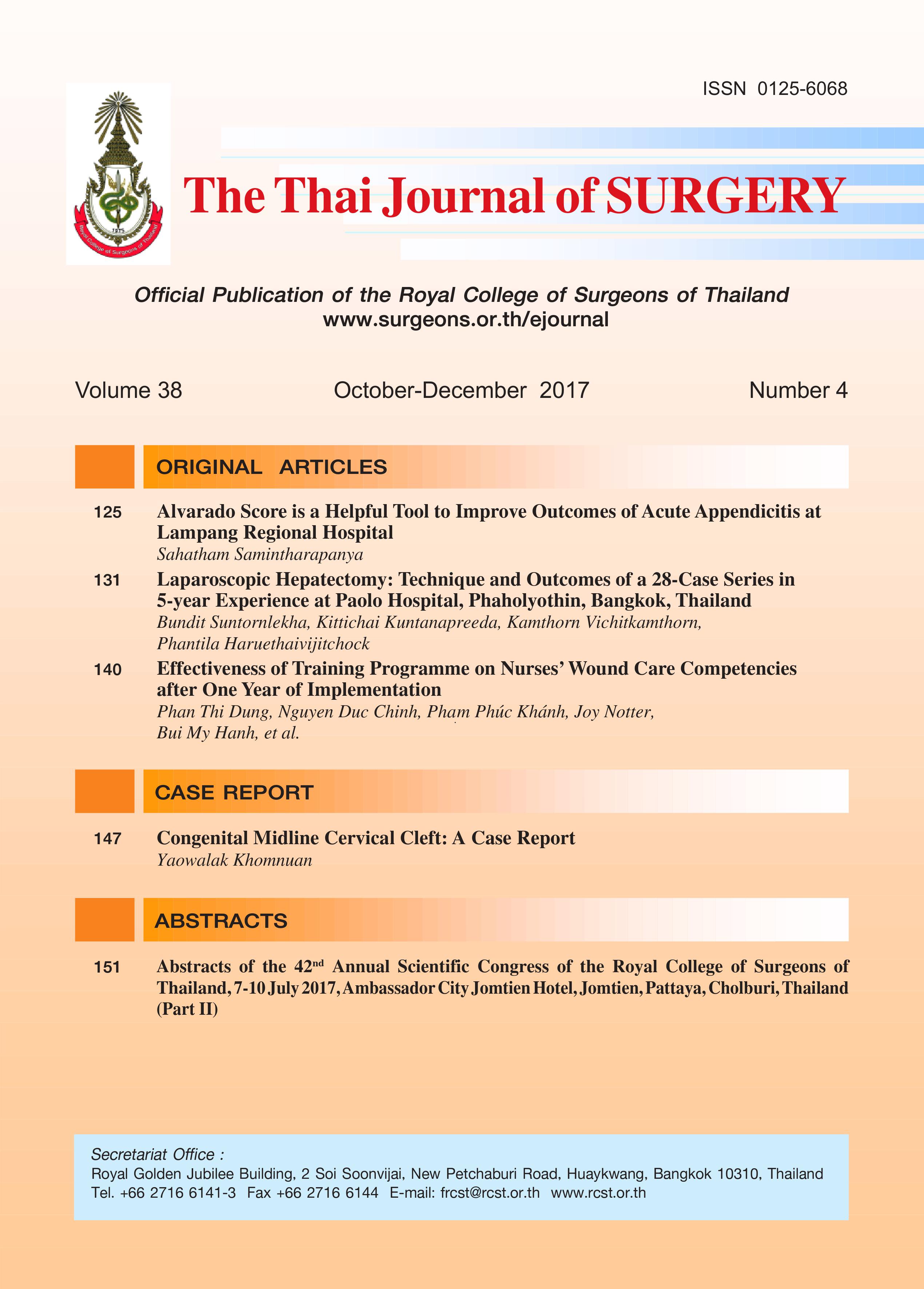Laparoscopic Hepatectomy: Technique and Outcomes of a 28-Case Series in 5-year Experience at Paolo Hospital, Phaholyothin, Bangkok, Thailand
Keywords:
Laparoscopic, hepatectomy, liver resectionAbstract
Background: Laparoscopic hepatectomy is a highly advanced, challenging surgical technique for liver resection surgery which obviously provides a bunch of benefits for the patients such as smaller incisions, easier approach to difficult area of tumor site, less tissue trauma, less intraoperative blood loss, less postoperative pain, quicker return of bowel function, shorter recovery period, and lower morbidity rates. However, to achieve success is not easy. It needs a readiness of several success factors including an expert surgeon as well as a specialized and experienced surgical team, sufficient and effective laparoscopic assisted surgical devices. This is why laparoscopic hepatectomy is still not a common seen operable procedure for liver resection in all surgical centers. This case series is to review our developing experience in laparoscopic hepatectomy along a 5-year journey of Paolo Phaholyothin Hospital.
Methods: Twenty-eight patients undergoing laparoscopic liver surgery between January 2013 and August 2017 were reviewed. The data set includes patient characteristics, indication for surgery and tumor description, operative procedure and duration, conversion to open surgery rates, intraoperative blood loss and blood component replacement, postoperative analgesic requirement, pathological reports, surgical outcomes and length of hospital stay.
Results: Age range from 36 to 94 years, male/female: 13/15, mean BMI: 25.4, 20/28 of lesions were malignant, and 8/28 benign. Operations included major right/left lobe hepatectomy (n = 8), segmentectomy (n = 20), and mean operative time: 277 minutes (range 120 to 585). Neither conversion to open operation nor reoperation was done. Mean intraoperative blood loss: 390 mL (range 20-2000) with only 3 cases received blood transfusion. Mean doses of postoperative opioid requirement: 2 (range 1-5), resumption of oral intake on postoperative day 2, ability to walk without support within 48 hours, median length of hospital stay: 6.6 (range 3-11), and return to work within 2 weeks. No case of prolong bile leakage or postoperative bleeding was recorded. Along our continuing follow-up time range 2-50 months, only 3 of 20 malignant cases had local disease recurrence, only 1 died due to heart disease and extreme aging.
Conclusion: Laparoscopic liver resection surgery has obviously more several superior advantages for the patients than open surgery. Even though to achieve success it needs to overcome many factors, but it is worth for the surgeons to push themselves forward harder and more to be an expert in this procedure.
References
2. Nguyen KT, Geller DA. Laparoscopic liver resection - current update. Surg Clin North Am 2010;90:749-60.
3. Buell JF, Cherqui D, Geller DA, et al. The international position on laparoscopic liver surgery: the Louisville Statement, 2008. Ann Surg 2009;250(5):825-30.
4. Tsuchiya M, Otsuka Y, Tamura A, et al. Status of endoscopic liver surgery in Japan: a questionnaire survey conducted by the Japanese Endoscopic Liver Surgery Study Group. J Hepatobiliary Pancreat Surg 2009;16:405-9.
5. Vigano L, Tayar C, Laurent A, Cherqui D. Laparoscopic liver resection: a systematic review. J Hepatobiliary Pancreat Surg 2009;16:410-21.
6. Reddy SK, Tsung A, Geller DA. Laparoscopic liver resection. World J Surg 2011;35:1478-86.
7. Sasaki A, Nitta H, Otsuka K, et al. Ten-year experience of totally laparoscopic liver resection in a single institution. Br J Surg 2009;96:274-9.
8. KitisinK, Packiam V, Bartlett DL, Tsung A. A current update on the evolution of robotic liver surgery. Minerva Chir 2011; 66:281-93.
9. D’Albuquerque LAC, Herman P. Hepatectomia por videolaparoscopia: Realidade? Arq Gastroenterol 2006; 43(3):243-6.
10. Herman P, Coelho FF, Lupinacci RM, et al. Resseçöes Hepáticas por videolaparoscopia. ABCD. Arq Bras Cir Dig 2009;22:226-32.
11. Kofron AJ, Geller D, Gamblin TC, Abecassis M. Laparoscopic liver surgery: shifting the management of liver tumors. Hepatology 2006;44:1694-700.
12. Machado MAC, Makdissi FF, Almeida FAR, et al. Hepatectomia Laparoscopi-cano Tratamentodas Metastases Hepaticas. Arq Gastroenterol 2008;45(4):330-2.
13. Machado MA, Makdissi FF, Galvao FH, Machado MC. Intrahepatic Glissonian approach for laparoscopic segmental liver resections. Am J Surg 2008;196:e38-42.
14. Ardito F, Tayar C, Laurent A, et al. laparoscopic liver resection for benign disease. Arch Surg 2007;142:1188-93; discussion 1193.
15. Robles Campos R, Marin Hernandez C, Lopez Conesa A, et al. Laparoscopic resection of the left segments of the liver: the “ideal technique” in experience centers?. Cir Esp 2009; 85:214-21. Spanish.
16. Cho JY, Han HS, Yoon YS, Shin SH. Outcomes of laparoscopic liver resection for lesion located in right side of the liver. Arch Surg 2009;144:25-9.
17. Gagner M, Rogula T, Selzer D. Laparoscopic liver resection: benefits and controversies. SurgClin North Am 2008;4:451-62.
18. Lee KF, Cheung YS, Chong CN, et al. Laparoscopic versus open Hepatectomy for liver tumours: a case control study. Hong Kong Med J 2007;13:442-8.
19. Carswel KA, Sagias FG, Murgatroyd B, et al. Laparoscopic versus open left lateral segmentectomy. BMC Surg 2009;9:14.
20. Nguyen KV, Geller DA. Is laparoscopic liver resection safe and comparable to open liver resection for hepatocellular carcinoma? Ann SurgOncol 2009;16:1765-7.
21. Pilgrim CHC, To H, Usatoff V, Evans PM. Laparoscopic Hepatectomy is a safe procedure for cancer patients. HPB 2009;11:247-51.
22. Cugat E, Marco C. Laparoscopic liver surgery. A mature option?. Cir Esp 2009;85:193-5.Spanish.
23. Gigot JF, Glineur D, Santiago Azagra J, et al. Hepatobiliary and Pancreatic Section of the Royal Belgian Society of Surgery and the Belgian Group for Endoscopic Surgery. Laparoscopic liver resection for malignant liver tumours: preliminary results of a multicenter European study. Ann Surg 2002;236:90-7.
24. Machado MAC, Makdissi FF, Herman P, Surjan RC. Intrahepatic glissonian approach for pure laparoscopic left hemihepatectomy. J Laparoendosc Adv Surg Tech A 2010; 20:141-2.
25. Cardinal JS, Reddy SK, Tsung A, Marsh JW, Geller DA. Laparoscopic Major Hepatectomy: Pure laparoscopic approach versus hand-assisted technique. J Hepatobiliary Pancreat Sci 2013;20:114-11.
Downloads
Published
How to Cite
Issue
Section
License
Articles must be contributed solely to The Thai Journal of Surgery and when published become the property of the Royal College of Surgeons of Thailand. The Royal College of Surgeons of Thailand reserves copyright on all published materials and such materials may not be reproduced in any form without the written permission.



